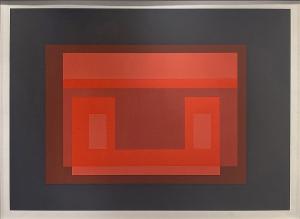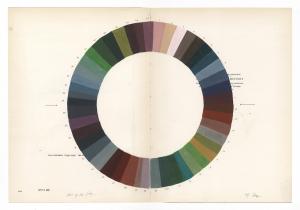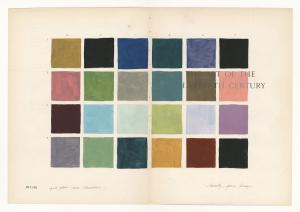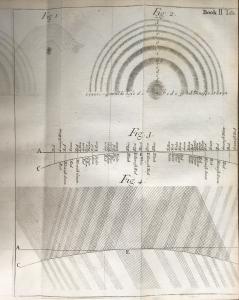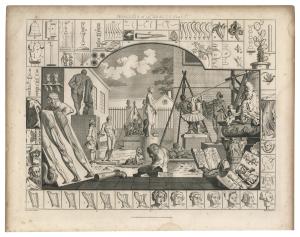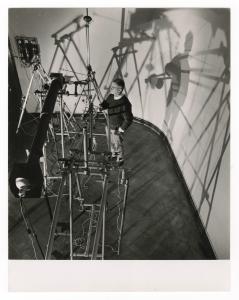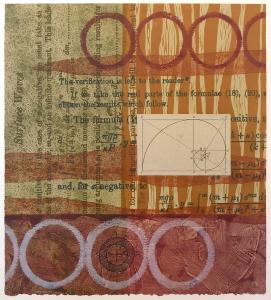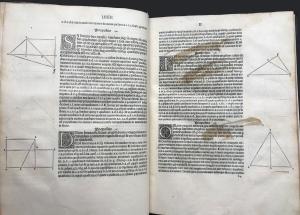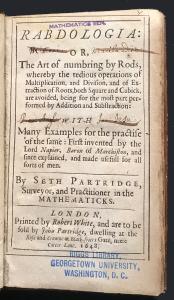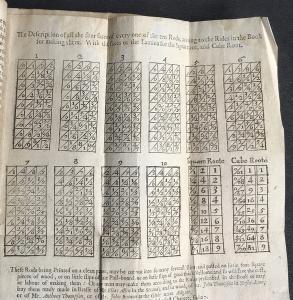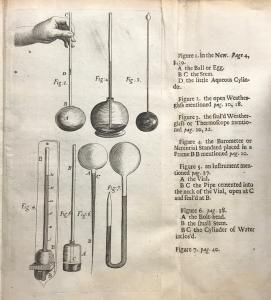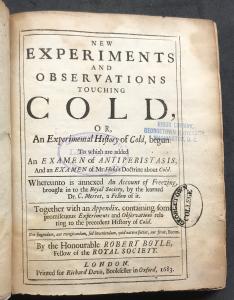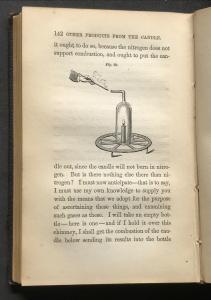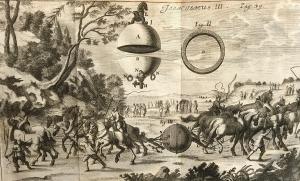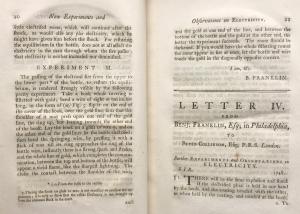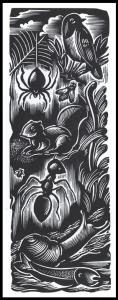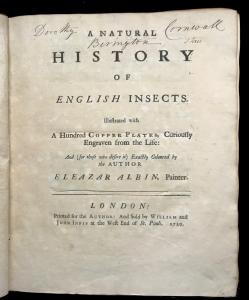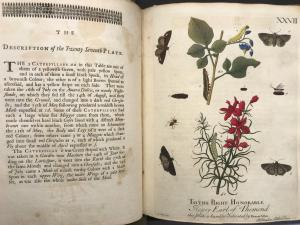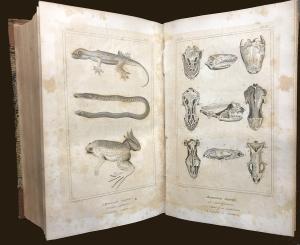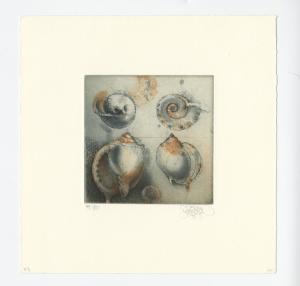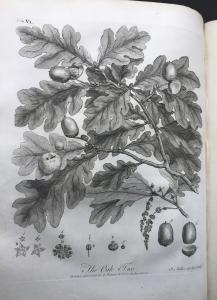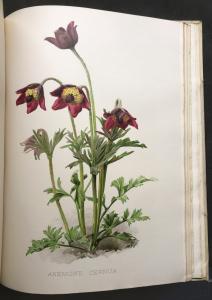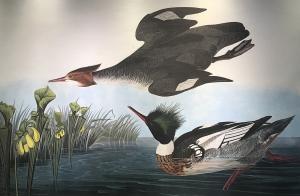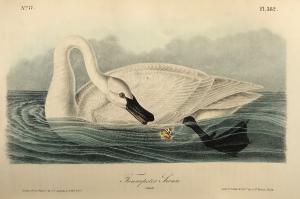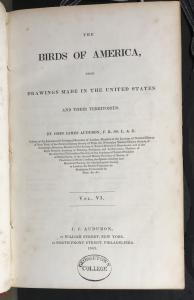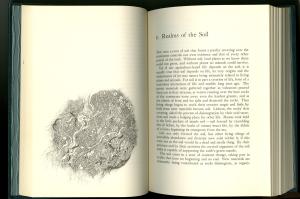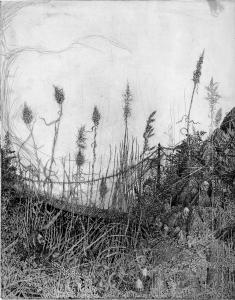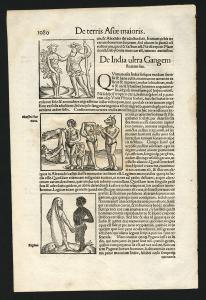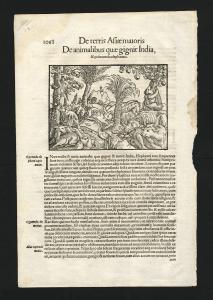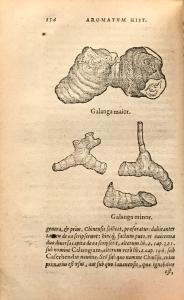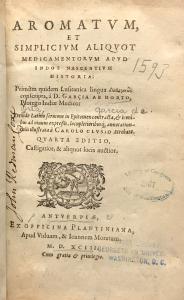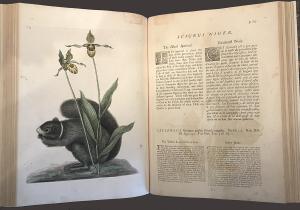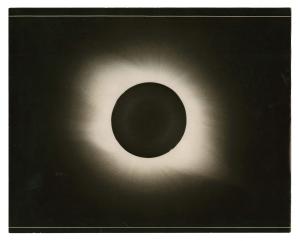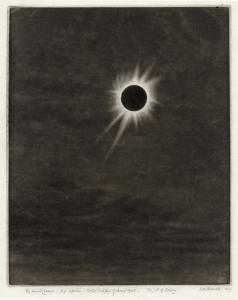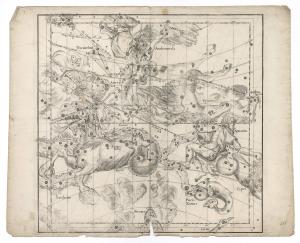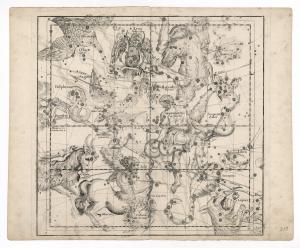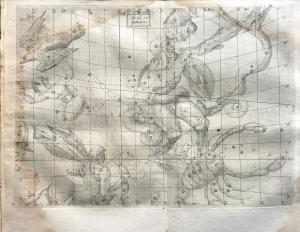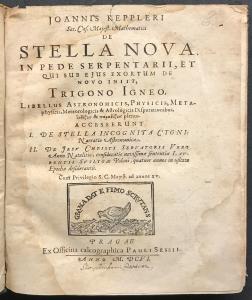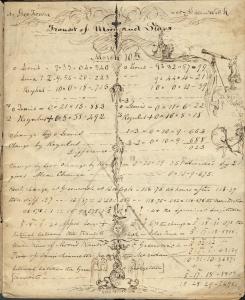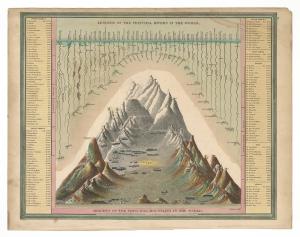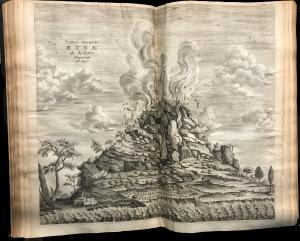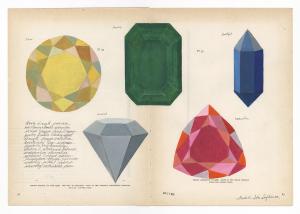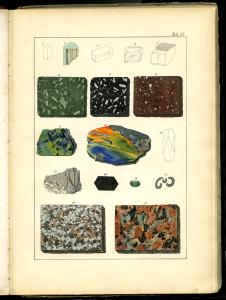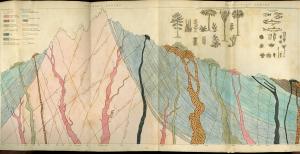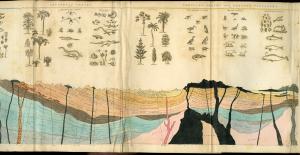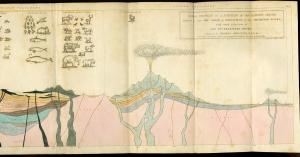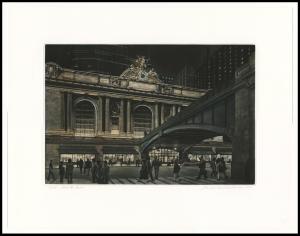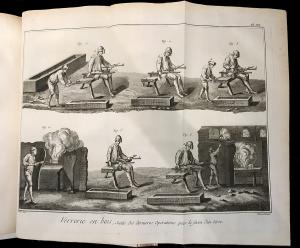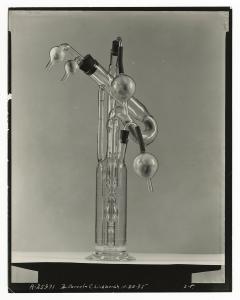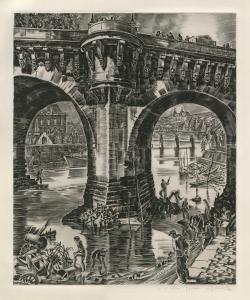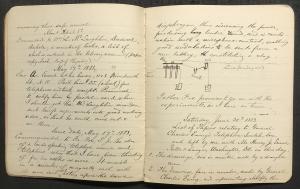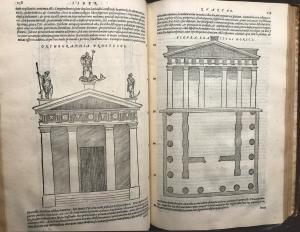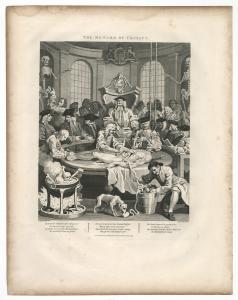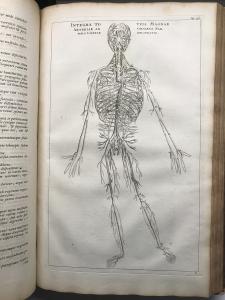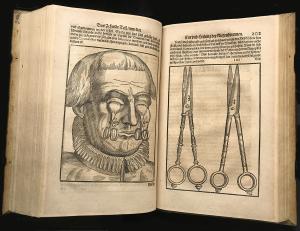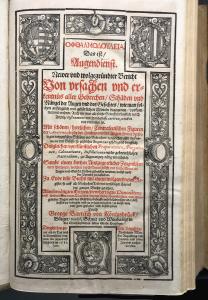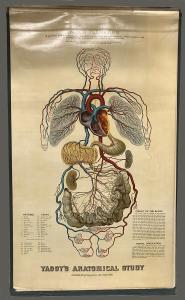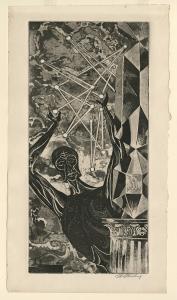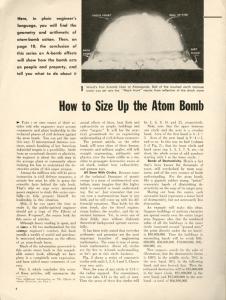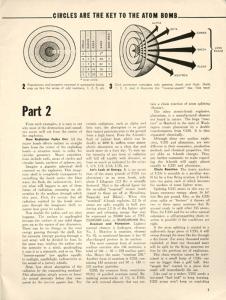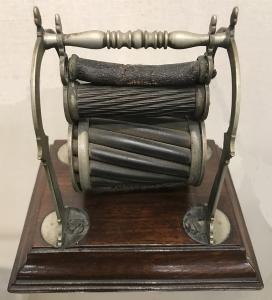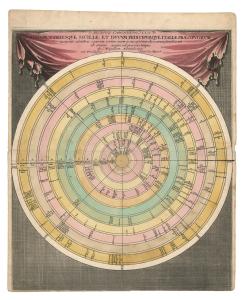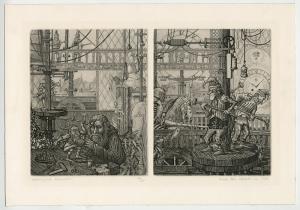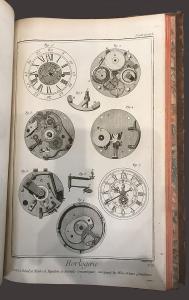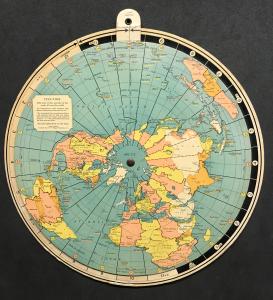All our knowledge has its origins in our perceptions.
--Leonardo da Vinci (translated by Jean Paul Richter)
Science is a largely visual endeavor. It elucidates the world of the material—atoms, minerals, flames, rivers, herbs, machines, skeletons, distant galaxies.
From the very beginnings of early modern scientific inquiry, the field of illustration has intertwined with the development of scientific knowledge. Image has mingled with text to communicate the discoveries, ideas, research and observations of the sciences.
This exhibition brings together some of the most magnificent examples of scientific illustration in the Booth Family Center for Special Collections, as well as some of the more curious and most speculative. Works of art, influenced by and influencing the sciences, share space with the illustrations throughout the exhibition.
Variant X (Ten Variants)
Josef Albers (1888-1976)
Screenprint published by Ives Sillman, 1967
University Art Collection 1993.29.1
German-born artist, teacher and color theorist Josef Albers came to the U.S. from Germany in 1933, when the Bauhaus art school in Weimar was shut down by the Nazis. He taught at Black Mountain College and at Yale. His influential 1963 book on color theory and perception, Interaction of Color, has never been out of print.
Color of the Day: 47 Days (APR 03 2020)
from the series Opposing Forces
Julie Wolfe (b. 1963)
2020
Acrylic with ink on found paper
Gift of Ingrid Rose in memory of Milton M. Rose
University Art Collection 2022.3.32.4
Julie Wolfe is a Washington, D.C.-based artist. Her work explores color and perception with an eye for design. From her website: "Synesthetic associations of color and shape demonstrate the slippage between different modes of communication, making meaning out of chance and play as well as deconstructing traditional aesthetic conventions."
First Phase – Color Translation: 24 Days (APR 03 2020)
From the series Opposing Forces
Julie Wolfe (b. 1963)
2020
Acrylic with ink on found paper
Gift of Ingrid Rose in memory of Milton M. Rose
University Art Collection 2022.3.32.5
Opticks: or, a Treatise of the Reflections, Refractions, Inflections and Colours of Light
Sir Isaac Newton (1642-1727)
London: Printed for W. Innys, 1730
Rare Book Collections, Gen 83A156
Open to: The Second Book of Opticks, Figs. 1-4 opposite p. 168.
In Opticks, Newton explored the fundamental nature of light and the colors within it.
Analysis of Beauty Plate I
Hogarth Restored. The Whole Works of the Celebrated William Hogarth
Thomas Cook (1744 – 1818), engraver
William Hogarth (1697 – 1764), copy after
London: John Stockdale, 1806
Engraving on paper
Gift of Alfred and Marie Louise Friendly
University Art Collection 2015.30.1.38
Hogarth’s book The Analysis of Beauty, first published in 1753, proposed six principles of visual beauty and theorized a serpentine “Line of Beauty,” seen here in Figure 49. Hogarth proposed #4 to be the most visually beautiful of the seven lines.
Rhythmogram: Prelude 3782/247
Heinrich Heidersberger (1906 – 2006)
1959
Photograph on Agfa paper (facsimile)
Gift of Lila Oliver Asher
University Art Collection 2018.13.6
German photographer Heinrich Heidersberger, known for his photographs of architectural subjects, was inspired by illustrations in a physics textbook to create visual representations of space-time relationships. His resulting rhythmograms record controlled movements of light directly onto photosensitive material.
Heidersberger with his Rhythmograph
Unknown Photographer
1955-1960
Photograph (facsimile)
Gift of Lila Oliver Asher
University Art Collection 2018.13.18
Heidersberger’s Rhythmograph used pendulums, commercial scaffolding, and mirrors. It evolved and grew more complex over time. Its final version, occupying over 200 square feet, still stands in his former workshop.
Math LIX
Martha Oatway
2002
Monotype with lithograph and collotype on paper
Gift of the artist on behalf of the Washington Print Club
University Art Collection 1111.1.567
This print was featured on the cover of the Summer 2003 Washington Print Club Quarterly, which included the following statement by the artist:
“Math Series was inspired by a hydrodynamics book published in 1890. Most pages are covered with individual equations and their derivations that are totally abstract visual images to me. The equations, punctuated by prose, become an exercise in positive and negative space. I combine the hard equations with organic forms from my etching, drypoint, and woodcut plates, and additional geometric symbols. By uniting the disparate elements of chaos and order, I have created my own visual language." (Artist's Statement in The Washington Print Club Quarterly, Summer 2003, Vol. 39, No. 2), page 2.
Elementa Geometriae
Euclid
Venice: Erhard Ratdolt, [25 May 1482]
Rare Book Collections, General 1482 .E6 Vault
Open to Book 2, Proposition 11, in which Euclid describes what would come to be called the Golden Ratio.
Rabdologia
Seth Partridge (1608-1686)
London: Robert White, 1648
Rare Book Collections, GTC G440
Open to: “The description of all the four faces of every one of the ten Rods….” opposite page 6.
Partridge describes this calculating device, invented by John Napier (1550-1617), as “the Art of Numbring by Rods, whereby the tedious operations of Multiplication, and Division, and of Extraction of Roots, both Square and Cubick, are avoided, being for the most part performed by addition and subtraction.”
Napier’s own book on “Napier’s rods” (or “bones”) and other calculating techniques, Rabdologiae, was published in Latin in 1617. Partridge explains that “according to my dark and mistie understanding in the Latin tongue, I collected out of the Lord Napiers Latin book, some rules and notes of the use of the Rods into English, for my own private use.” He was eventually persuaded to publish his notes, “for the use of all.”
New Experiments and observations touching cold, or, An experimental history of cold begun…
Robert Boyle (1627-1691)
London: Printed for Richard Davis…,1683
Rare Book Collections, General 84A132
Open to Figures 1-7, opposite page 40. Anglo-Irish natural philosopher Robert Boyle is often called the “father of chemistry.” His work extended into physics, medicine, alchemy, natural theology and more. He discovered what came to be called Boyle’s law: the inverse relationship between volume and pressure in a gas, where temperature remains constant.
A Course of Six Lectures on the Chemical History of a Candle: to which is added a lecture on platinum
Michael Faraday (1791-1867)
New York: Harper & Brothers, 1861
Rare Book Collections, General 75A208
Open to “Figure 29” p. 142.
British chemist and physicist Michael Faraday is perhaps best known for his contributions to the understanding of electromagnetism and electrochemistry. Largely self-taught, he discovered the “Faraday effect,” linking electromagnetism and light, and invented the “Faraday cage,” which blocks electrical fields.
Technica curiosa
Gaspar Schott (1608-1666)
Herbipoli : Sumptibus Wolfgangi Mauritii Endteri, excudebat Jobus Hertz ..., 1687
Rare Book Collections, General 88A402
German Jesuit scientist and teacher Gaspar Schott was for a time assistant to Athanasius Kircher, S.J. at the Collegio Romano, and often stands in Kircher’s shadow. However, Schott was a prolific author in his own right. Much of his work consists of compilations of the research, scientific work and explorations of others. Figure 11, opposite page 39 of Technica curiosa, illustrates the Magdeburg hemispheres experiment in 1654, when mayor of Magdeburg Otto Von Guericke demonstrated the effects of a vacuum and atmospheric pressure by putting two copper hemispheres together, evacuating the air inside, and then attempting to pull the hemispheres apart.
Experiments and observations on electricity, made at Philadelphia in America.
Benjamin Franklin (1706-1790)
London: Printed for F. Newbury, 1774
Rare Book Collections, Shea QC516 .F85 1774 Vault
Open to Plate 1, opposite the title page. Fig. x illustrates Franklin’s Experiment 11.
The slightly alarming proposed experiment is displayed here in its entirety: it begins “Take a book whose covering is filleted with gold…” and ends “If you would have the whole filletting round the cover appear in fire at once, let the bottle and wire touch the gold in the diagonally opposite corners.”
Untitled [Ant, for Steve Miller, U. of A.]
John de Pol (1913-2004)
1995
Wood engraving on paper
University Art Collection 1992.1.139
A Natural History of English Insects
Eleazar Albin (c. 1680-c. 1742)
London: Printed for the author and sold by William and John Innys at the West End of St. Pauls, 1720
Purchase, 2021
Rare Book Collections, Gen LC QL466.A3 1720 Vault
Open to Plate XXVII.
Artist and naturalist Eleazar Albin taught art by profession; he also drew and painted for some of the leading naturalists of the time.
Albin prided himself on the visual accuracy of his illustrations and the colors he used, and promised his subscribers that he would never try to “make the Picture outdo Nature.”
The Animal Kingdom Arranged in Conformity with its Organization, Volumes 1 and 2
Baron Georges Cuvier (1769-1832)
(Henry McMurtrie, translator)
New York: G. & C. & H. Carvill, 1831
Rare Book Collections, General 99A33
Open to Plates III and IV of volume 2.
Plate III depicts “new species of Sauria;” Plate IV “shows the osteology of certain anomalous Serpents.”
French zoologist Georges Cuvier is credited with establishing the sciences of comparative anatomy and paleontology. In The Animal Kingdom he arranges animals into four groups—vertebrates, mollusks, articulates and radiates. His arrangements are no longer used, but at the time were a significant advance over existing classification systems.
Four Shells
Jörg Schmeisser (1942 – 2012)
1995
Etching on paper
49/60
Gift of Eric Denker in memory of
Reverend Joseph A. Haller, S.J., 2017
University Art Collection 1997.12.2
The German-born master printmaker Jörg Schmeisser traveled widely throughout East Asia and became the Head of Printmaking at the Australian National University in Canberra in 1978. The Library mounted exhibitions on Schmeisser's work in 1997 and 2015, both curated by Eric Denker.
Silva, or, A Discourse of Forest-Trees, and the propagation of timber in his Majesty’s dominions
John Evelyn (1620-1706)
York: Printed by A. Ward for J. Dodsley; T. Cadell; J. Robson; R. Baldwin; J. Todd, 1786
Woodstock Rare Book Collections, 634 .9 EV22 Cube
Open to “The Oak Tree” opposite p. 67.
British writer and horticulturalist John Evelyn wrote Sylva as a plea to English landowners to plant trees, most especially to ensure enough timber to support the needs of the British Navy. Evelyn was a founding Fellow of the Royal Society; his multi-volume Diary is a detailed and informative historical record of the events of his era.
Flora and Sylva, Volume 1
William Robinson (1838-1935), editor
London: Published at 17, Furnival Street, 1903
Thomas J. Healey Family Collection; Gift of Thomas J. Healey, 2016
Rare Book Collections, General LC Folios SB1 .F5
Open to Anemone cernua, opposite p. 278 (November, 1903 issue). This monthly journal, published from April 1903 to December 1905, was created, edited, printed and published by William Robinson. The journal featured articles from well-known horticulturalists and included stunning colored plates by the artist Henry Moon.
Robinson’s hugely influential books and other writings, including The Wild Garden and The English Flower Garden, revolutionized the idea of the garden in the U.K. and beyond.
Red-breasted Merganser
John James Audubon (copy after)
1972
Photolithograph on paper
Gift of Jane and Gary Filerman
University Art Collection 2005.13.29
The Birds of America: from drawings made in the United States and their territories, Volume 6
John James Audubon (1706-1790)
New York: Published by J. J. Audubon; Philadelphia: J. B. Chevalier
Rare Book Collections, Shandelle QL674 .A9 1840 Vault
First Royal Octavo Edition with hand colored lithographs from the engravings of the Double Elephant Folio Edition. Open to Plate 382, Trumpeter Swan.
When Audubon decided to create a “miniature” version of the original double-elephant folio edition of Birds of America (26 ½” x 39 ½”), a camera lucida was used to trace the images at octavo (10 ¼” x 6 ½”) size. A camera lucida uses a glass prism held at eye level above a piece of drawing paper. Looking through the prism, a reflection of the original image can be seen apparently lying on the drawing paper underneath it, and thus the image can be traced at a smaller size.
Silent Spring
Rachel Carson (1907-1964)
Louis and Lois Darling, illustrators
Boston: Houghton Mifflin, 1962
Rare Book Collections, General LC SB959 .C3 1962
First edition, signed by author and illustrators. Open to pp. 52-53.
Marine scientist Rachel Carson’s classic book challenged the safety of synthetic pesticides, introduced a broad audience to concerns about DDT, helped launch a grassroots environmental movement and continues to inspire ecologists to this day.
The Journey is the Teacher
Mark Alan Leithauser (b. 1950)
1973
Etching on paper
Artist’s proof
Gift of the artist, 2002
University Art Collection 2002.18.1
De India ultra Gangem and De animalibus quae gignit India
From Cosmographia Universalis
Sebastian M. Münster (1489 – 1552)
Basel: Heinrich Petri, 1550
Letterpress with woodcut on paper
Gift of Joseph E. Jeffs, 2008, 2009
University Art Collection 2008.17.27, 2009.3.22
Münster’s Cosmographia, the first German-language description of the world, was scientifically cutting-edge in its use of empirical data and mathematical cartography—for those parts of the world for which Münster had direct experience or colleagues to send him information.
Curious images of “human monsters” in Cosmographia’s Asia and Africa, on the other hand, likely relied on descriptions in the Natural History of Pliny the Elder (AD 23/24-79). The animals of India displayed include a unicorn and a petite elephant.
Aromatum, et simplicium aliquot medicamentorum apud Indos nascentium histori
Garcia da Orta (c. 1500-c. 1568)
Antuerpiae : Ex Officina Plantiniana, apud viduam, & Joannem Moretum, 1593
Rare Book Collections, Shandelle RS180 .I4 078 1593
Open to p. 154, “Galanga maior” and “Galanga minor”
In contrast to the speculative pages on India from the Cosmographia (above), Portuguese physician and herbalist Garcia da Orta’s writing came from personal experience. He sailed for Portuguese India in 1534 and practiced medicine there until his death in1568. His Colóquios dos simples e drogas e coisas medicinais da India e de algumas frutas (Colloquies on the Simples and Drugs of India) was first printed in Goa in 1563. Our copy is the later Latin translation and abridgement made by Carolus Clusius and first published by the Plantin press in Antwerp in 1567.
Da Orta’s Aromatum provided many Western scholars with a valuable introduction to tropical medicine, pharmacology, botany and the cultivation and uses of the herbs and food plants of India.
The natural history of Carolina, Florida and the Bahama islands: containing the figures of birds, beasts, fishes, serpents, insects, and plants; particularly the forest-trees, shrubs, and other plants, not hitherto described, or very incorrectly figured by authors….
Mark Catesby (1683-1749)
London: Printed at the expense of the author, and sold by W. Innys and R. Manby etc.
Rare Book Collections, General 77VB1
George and Martha Washington owned this copy of Catesby’s Natural History. Catesby, an English naturalist, was sent by the Royal Society to collect seeds and other botanical specimens in Carolina. He travelled far and wide in the new world, collecting both plants and animals.
The book came to George and Martha Washington through the Custis family line. It was donated to Georgetown College by George Washington Parke Custis in 1833.
Theory of the Orders
Julie Wolfe (b. 1963)
2020
Acrylic with ink on found paper
Gift of Ingrid Rose in memory of Milton M. Rose
University Art Collection 2022.3.32.11
Total Eclipse of the Sun, August 31 1932
Heinz Rosenberger
1932
Photograph (facsimile)
Manuscript Collections, Alexis Carrel Papers, Box 9
Rosenberger, a colleague of Alexis Carrel’s, also invented a micro-cinematograph, a camera that captured microscopic motion pictures.
The Sun’s Corona – S.E. Spain – Total Eclipse of Aug. 1905
Frederic Dawtrey Drewitt (1848–1942)
1907
Mezzotint on paper
Purchase, 2000
University Art Collection 2000.16.1
Drewitt was a member of the Royal College of Physicians, a watercolor artist who exhibited at the Royal Academy, and author of several books including a biography of Edward Jenner and a history of the Chelsea Physic Garden in London (shown here on loan).
Vernal Equinox (plate 2)
Globi Coelestis in Tabulas Planas Redacti Descriptio [A Description of the Celestial Globes Reduced to Flat Tables]
Guillaume Vallet (1632 – 1704), engraver
Ignace-Gaston Pardies (1636 – 1673), author
Paris: 1674
Engraving on paper
Gift of Eric F. Menke, 1979
University Art Collection 1979.6.134
Winter Solstice (plate 5)
Globi Coelestis in Tabulas Planas Redacti Descriptio [A Description of the Celestial Globes Reduced to Flat Tables]
Guillaume Vallet (1632 – 1704), engraver
Ignace-Gaston Pardies (1636 – 1673), author
Paris: 1674
Engraving on paper
Gift of Eric F. Menke, 1979
University Art Collection 1979.6.135
De Stella Nova in Pede Serpentarii
Johannes Kepler (1571-1630)
Pragae: Ex officina calcographica Pauli Sessii, 1606
Gift of Lewis Strauss, 1985
Rare Book Collections, General 86VA6
Open to star map opposite page 76. Kepler’s “new star” appeared in the foot of the constellation Serpent Bearer in 1604. The supernova (SN 1604) was visible for almost a year, and Kepler kept astonishingly meticulous records of his observations.
Transit of Moon and Stars (embellished)
Edmund Reuel Smith (1829-1911)
March 10, 1846
Observatory Files
GTA-000193, Box 1
University Archives
The Georgetown College Observatory, constructed in the early 1840s, provided student Edmund Smith (C’1848) and other researchers the opportunity to study and map the skies. Smith found time, on this particular night of written observations, to enhance the page with elaborate sketches. He worked as an expedition artist after graduation.
Soviet Lunar Globe
1967
University Archives
This lunar globe likely came to the University Archives from the Georgetown University Astronomical Observatory.
Professor Yuri Naumovich Lipsky (1909–1978) led the study of the first photographs of the far side of the moon, from the Luna-3 spacecraft flyby in 1959 and the Zond-3 flyby in 1965. The first full globes of the moon’s surface, as well as selenographic maps, were produced under his direction.
Lengths of the Principal Rivers in the World / Heights of the Principal Mountains in the World
F. Humphrys, engraver
S. A. Mitchell, (1790 – 1868), editor
Philadelphia: S. A. Mitchell, 1846
Lithograph with hand coloring on paper
Gift of Eric F. Menke, 1979
University Art Collection 1979.6.108
From: A New Universal Atlas Containing Maps of the various Empires, Kingdoms, States and Republics of the World…
Mundus Subterraneus
Athanasius Kircher (1602-1680)
Amstelodami: Apud Joannem Janssonium & Elizeum Weyerstraten…, 1665
Woodstock Rare Books Collection 550 K532 Vault
(open to Typus Montis Aetnae ab Authore Observati Ao 1637)
and
Rare Book Collections, General 79B29
(open to Systema Ideale Pyrophylaciorum…)
Polymath and Jesuit scholar Athanasius Kircher held a seemingly unlimited number of interests, published dozens of volumes, and taught for 40 years at the Collegio Romano. Many of his ideas did not stand the test of time. However, his vision of the interconnectedness of fire beneath and throughout the subterranean spaces of the earth, occasionally overflowing in volcanic eruptions, was insightful. Shown here is Kircher’s vision of those underground fires and his impression of Mt. Etna in 1637.
Indeed It’s Influence (APR 28 2020)
From the series Opposing Forces
Julie Wolfe (b. 1963)
2020
Acrylic with ink on found paper
Gift of Ingrid Rose in memory of Milton M. Rose
University Art Collection 2022.3.32.9
Das Mineralreich in Bildern: Naturhistorisch-technische Beschreibung und Abbildung der wichtigsten Mineralien
J. G. (Johann Gottlob) von Kurr (1798-1870)
Stuttgart und Esslingen: Verlag von Schreiber und Schill, 1858
Rare Book Collections, Gen LC Folios QE372 .K96 1858
Open to Table VI: Feldspathic Minerals and Rocks, Micaceous Minerals, Granite.
Johann Gottlob von Kurr, German pharmacist and naturalist, published this volume while professor of mineralogy and botany at the Stuttgart Polytechnic Institute.
Geology and Mineralogy considered with reference to natural theology, Volume 2
William Buckland (1784-1856)
Philadelphia: Carey, Lea and Blanchard, 1837
Woodstock Rare Book Collections, 1837.5 Cube
Open to “Ideal section of a portion of the earth’s crust, intended to shew the order of deposition of the stratified rocks, with their relations to the unstratified rocks.”
British geologist, paleontologist and minister William Buckland sought to reconcile scientific discoveries with the Bible. He proposed in this volume that changes in the fossil record over time could be explained by successive divine acts of creation. Among other achievements, Buckland discovered fossil bones of a giant reptile which he named Megalosaurus, writing up the first full account of what would come to be called a dinosaur. He was appointed Dean of Westminster in 1845.
Above the Rush
Frederick W. Mershimer (b. 1958)
2003
Mezzotint on paper
32/120
University Art Collection 1111.1.6600
Encyclopédie, ou, Dictionnaire raisonné des sciences, des arts et des métiers, Volume 33
Denis Diderot and Jean le Rond d’Alembert, editors
A Paris : Chez Briasson, rue Saint Jacques, à la Science ; Chez David l'aîné, rue Saint Jacques, à la Plume d'or ; Chez Le Breton, Imprimeur ordinaire du Roy, rue de la Harpe ; Chez Durand, rue Saint Jacques, à Saint Landry, & au Griffon, 1751-1780
Rare Book Collections, Detroit Folios AE25 .E53 1751
Open to one of the many plates related to glass-making and glass-blowing.
Carrel-Lindbergh Perfusion Pump
Unknown Photographer
ca. 1935
Photograph (facsimile)
Manuscript Collections, Alexis Carrel Papers, Box 9
Aviator Charles Lindbergh (1902–1974) and Dr. Alexis Carrel (187 –1944) combined mechanical genius with Nobel-Prize-winning medical innovation to produce this device, which keeps tissues alive in a sterile, closed system. Carrel received the 1912 Nobel Prize for Physiology and Medicine for his work in vascular surgery.
La Seine Asséchée, Pont Neuf
[The Seine Drained]
Albert Decaris (1901 – 1988)
Line engraving on paper
Purchase, 1996
University Art Collection 1996.14.28
J. Havens Richards’ Notebook
J. Havens Richards, S. J., Papers
GTA-20211201, Box 2, Folder 2
University Archives
J. Havens Richards, S.J. served as the 30th President of Georgetown College from 1888-1898. This 1882-1888 journal, kept while he was a Georgetown professor of physics and mathematics, ranges across many subjects including, on May 17, 1883, “the idea of a loud speaking telephone receiver and telephone relay that I have been thinking of for two weeks or more.” Sketches accompany his description of the invention. He decides, however, to share his idea with colleague Fr. Fox S.J. “Father Fox,” he says, “promised to go on with the experiments, as I have no time.”
De architectura
Vitruvius Pollio (active 1st century B.C.E.)
Venetiis : Apud Franciscum Franciscium Senensem, & Ioan. Crugher Germanum, 1567
Rare Book Collections, General 79A259
Open to pp. 138-139.
Roman architect Vitruvius’ three necessary attributes for architecture—strength, utility, and beauty—are articulated in De architectura.
The Reward of Cruelty
Hogarth Restored. The Whole Works of the Celebrated William Hogarth
Thomas Cook (1744 – 1818), engraver
William Hogarth (1697 – 1764), copy after
London: John Stockdale, 1806
Engraving on paper
Gift of Alfred and Marie Louise Friendly
University Art Collection 2015.30.1.49
This engraving is the last in a series of four Hogarth works, The Four Stages of Cruelty. A fictional character, Tom Nero, is followed through the stages of cruelty: to a dog, then to a horse, then to murder. His reward is shown here: after a public hanging, his body is taken for public dissection.
Andreae Vesalii invictissimi Caroli V. Imperatoris medici Opera omnia anatomica & chirurgica
Andreas Vesalius (1514-1564)
Lugduni Batavorum [Netherlands]: Apud Joannem du Vivie et Joan. Herm. Verbeek Bibliop., 1725
Rare Book Collections, GenLC Folios QM21 .V42 1725 Vault
Open to #41.
Andreas Vesalius is considered the founder of modern anatomy.
Ophthalmodouleia
Georg Bartisch (1535–1607)
Dresden: Matthes Stöckelaris, 1583
Gift of Mrs. G. William Schlindwein
Rare Book Collections, Shandelle Folios RE41 .B3 1583 Vault
Open to pp. 201-202.
Bartisch, considered by many to be the father of modern ophthalmology, published his book on ophthalmic disorders and eye surgery in German rather than the traditional Latin. Though not academically trained, he became court oculist to Duke Augustus I of Saxony.
Yaggy’s Anatomical Study: Presenting the Skeleton, Muscles, Arteries, Veins and Nerves: Also Four Life-Size Manikins of the Body, the Head, the Eye and the Ear…
Levi Walter Yaggy (1848 – 1912)
Chicago: Western Publishing House, 1884
Lithograph on paper
Fairchild Endowment Fund purchase, 2020
University Art Collection 2020.9.1
Publisher Levi Yaggy was president of the Great Western Publishing House, based in Chicago. The majority of its business centered on maps and related materials for college and high school classroom use.
While Maintaining the Emotional Tension (MAY 12 2020) [with Susan Sontag quote]
from the series Opposing Forces
Julie Wolfe (b. 1963)
2020
Acrylic with ink on found paper
Gift of Ingrid Rose in memory of Milton M. Rose
University Art Collection 2022.3.32.12
The Atom
Harry Sternberg (1904–2001)
1950
Etching with aquatint on paper
Art Collection Purchase, 1987
University Art Collection 1987.5.11
How to Size Up the Atom Bomb
New York: McGraw Hill, ca. 1951
Rare Book Collections, General 98A1498
“A Report from Power, a McGraw-Hill publication devoted to generation, transmission and application of the power services.”
Open to pp. 4-5.
A tag line on the front cover reads: “Now every engineer can learn how to size up the atom bomb.”
Sections from the First Atlantic Telegraph Cable
Atlantic Telegraph Company (est. 1856)
1857
Gift of Mihran H. Kevorkian, 1952
University Art Collection MSS.1111.1.6598
Copper, iron, and gutta-percha cables mounted in brass on wood display stand. This piece commemorates the laying of the first telegraph line between New York and England in 1859. The largest diameter cable connected Newfoundland to Ireland, the medium was used in shallow water connections, and the smallest in overland connections. The commemorative piece was given to Georgetown by the niece of Georgetown alumnus Admiral J. Jackson McElmell (MA’1872). McElmell played a part in the laying of the original cable. The Jackson McElmell Papers are part of the Library’s manuscript collections (GTM-GAMMS241).
Discus Chronologicus Regum Utriusque Siciliae et Ducum Principumque Italiae Praecipuorum
Christoph Weigel (1654–1725)
Nuremberg: Johann Ernst Adelbulner, 1718
Engraving with hand coloring on paper
Gift of Eric F. Menke, 1979
University Art Collection 1979.6.110
This timewheel of regional rulers in Italy originally came with a spinning pointer to help cross-reference across regions and reigns.
Horological Fascination
Mark Alan Leithauser (b. 1950)
1974
Etching with engraving on paper
66/75
Purchase, 1998
University Art Collection 1998.19.1
Encyclopédie, ou, Dictionnaire raisonné des sciences, des arts et des métiers, Volume 27
Denis Diderot and Jean le Rond d’Alembert, editors
A Paris : Chez Briasson, rue Saint Jacques, à la Science ; Chez David l'aîné, rue Saint Jacques, à la Plume d'or ; Chez Le Breton, Imprimeur ordinaire du Roy, rue de la Harpe ; Chez Durand, rue Saint Jacques, à Saint Landry, & au Griffon, 1751-1780
Rare Book Collections, Detroit Folios AE25 .E53 1751
The Encyclopédie encompassed 17 volumes of text, 11 volumes of plates, and more than 140 contributors. Shown here is one of the many plates related to watch-making. Contributors to this published work included the most influential authors of the Enlightenment and the Scientific Revolution.
A Wrinkle in Time
Madeleine L’Engle
New York City: Farrar, Straus and Cudahy, 1962
Gift of Thomas J. Healey, 2016
General LC PS3523 .E55 W75 1962 Vault
First edition, signed. Open to pp. 76-77.
Mrs. Who and Mrs. Whatsit explain a tesseract to Meg, and how they use it to create a shortcut between two points in space and time.
Tele-Time
S. W. (Samuel Whittemore) Boggs
Washington, D. C., 1932
Map Collection (GRB-20211220)
This time disk, for which S. W. Boggs requested a patent in 1932, “tells time of day, and day of the week, all over the world” once the top disk is spun to the user’s own current time. Mr. Boggs was granted his patent for a “Horological Instrument and Related Devices” in September 1936.
Exhibition curated by:
Christen Runge, Assistant Curator, University Art Collection
Stephanie Hughes, Projects and Communications Coordinator, Booth Family Center for Special Collections

